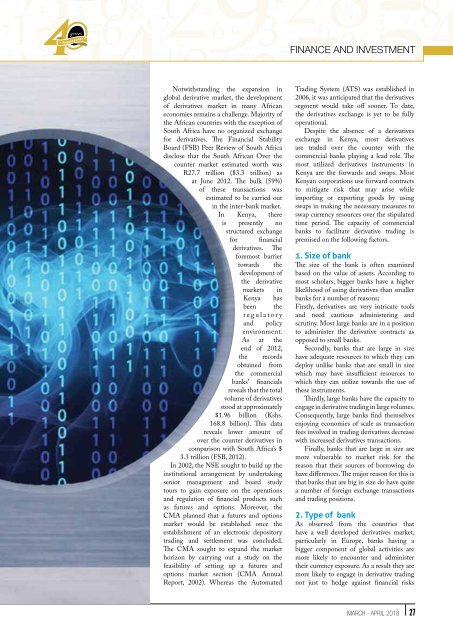The-Accountant-Mar-Apr-2018
You also want an ePaper? Increase the reach of your titles
YUMPU automatically turns print PDFs into web optimized ePapers that Google loves.
Finance and investment<br />
Notwithstanding the expansion in<br />
global derivative market, the development<br />
of derivatives market in many African<br />
economies remains a challenge. Majority of<br />
the African countries with the exception of<br />
South Africa have no organized exchange<br />
for derivatives. <strong>The</strong> Financial Stability<br />
Board (FSB) Peer Review of South Africa<br />
disclose that the South African Over the<br />
counter market estimated worth was<br />
R27.7 trillion ($3.3 trillion) as<br />
at June 2012. <strong>The</strong> bulk (59%)<br />
of these transactions was<br />
estimated to be carried out<br />
in the inter-bank market.<br />
In Kenya, there<br />
is presently no<br />
structured exchange<br />
for financial<br />
derivatives. <strong>The</strong><br />
foremost barrier<br />
towards the<br />
development of<br />
the derivative<br />
markets in<br />
Kenya has<br />
been the<br />
regulatory<br />
and policy<br />
environment.<br />
As at the<br />
end of 2012,<br />
the records<br />
obtained from<br />
the commercial<br />
banks’ financials<br />
reveals that the total<br />
volume of derivatives<br />
stood at approximately<br />
$1.96 billion (Kshs.<br />
168.8 billion). This data<br />
reveals lower amount of<br />
over the counter derivatives in<br />
comparison with South Africa’s $<br />
3.3 trillion (FSB, 2012).<br />
In 2002, the NSE sought to build up the<br />
institutional arrangement by undertaking<br />
senior management and board study<br />
tours to gain exposure on the operations<br />
and regulation of financial products such<br />
as futures and options. Moreover, the<br />
CMA planned that a futures and options<br />
market would be established once the<br />
establishment of an electronic depository<br />
trading and settlement was concluded.<br />
<strong>The</strong> CMA sought to expand the market<br />
horizon by carrying out a study on the<br />
feasibility of setting up a futures and<br />
options market section (CMA Annual<br />
Report, 2002). Whereas the Automated<br />
Trading System (ATS) was established in<br />
2006, it was anticipated that the derivatives<br />
segment would take off sooner. To date,<br />
the derivatives exchange is yet to be fully<br />
operational.<br />
Despite the absence of a derivatives<br />
exchange in Kenya, most derivatives<br />
are traded over the counter with the<br />
commercial banks playing a lead role. <strong>The</strong><br />
most utilized derivatives instruments in<br />
Kenya are the forwards and swaps. Most<br />
Kenyan corporations use forward contracts<br />
to mitigate risk that may arise while<br />
importing or exporting goods by using<br />
swaps in making the necessary measures to<br />
swap currency resources over the stipulated<br />
time period. <strong>The</strong> capacity of commercial<br />
banks to facilitate derivative trading is<br />
premised on the following factors.<br />
1. Size of bank<br />
<strong>The</strong> size of the bank is often examined<br />
based on the value of assets. According to<br />
most scholars, bigger banks have a higher<br />
likelihood of using derivatives than smaller<br />
banks for a number of reasons;<br />
Firstly, derivatives are very intricate tools<br />
and need cautious administering and<br />
scrutiny. Most large banks are in a position<br />
to administer the derivative contracts as<br />
opposed to small banks.<br />
Secondly, banks that are large in size<br />
have adequate resources to which they can<br />
deploy unlike banks that are small in size<br />
which may have insufficient resources to<br />
which they can utilize towards the use of<br />
these instruments.<br />
Thirdly, large banks have the capacity to<br />
engage in derivative trading in large volumes.<br />
Consequently, large banks find themselves<br />
enjoying economies of scale as transaction<br />
fees involved in trading derivatives decrease<br />
with increased derivatives transactions.<br />
Finally, banks that are large in size are<br />
more vulnerable to market risk for the<br />
reason that their sources of borrowing do<br />
have differences. <strong>The</strong> major reason for this is<br />
that banks that are big in size do have quite<br />
a number of foreign exchange transactions<br />
and trading positions.<br />
2. Type of bank<br />
As observed from the countries that<br />
have a well developed derivatives market,<br />
particularly in Europe, banks having a<br />
bigger component of global activities are<br />
more likely to encounter and administer<br />
their currency exposure. As a result they are<br />
more likely to engage in derivative trading<br />
not just to hedge against financial risks<br />
MARCH - APRIL <strong>2018</strong> 27

















